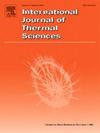Influence of trailing edge thickness and deflection on the performance of a ram air turbine for hypersonic vehicle power generation
IF 4.9
2区 工程技术
Q1 ENGINEERING, MECHANICAL
International Journal of Thermal Sciences
Pub Date : 2025-02-26
DOI:10.1016/j.ijthermalsci.2025.109821
引用次数: 0
Abstract
A ram air turbine power generation system can address the energy utilization challenges of hypersonic vehicles. However, as the maximal flight Mach number of hypersonic vehicles is constantly increased, the total temperature of the incoming airflow becomes extremely high, making it unsuitable for cooling purposes. Therefore, active cooling of the ram air turbine must be achieved using fuel as a heat sink. Applying active cooling by arranging internal cooling channels at the main hotspot like blade edge may lead to thickening and additional deflection of trailing edge. This study focuses on an impulse ram air turbine stage and introduces a continuous curvature profiling method for ram air turbines. The turbine performance is evaluated by numerical simulations under varying trailing edge thicknesses and deflection. Then, an efficiency correction model that accounts for trailing edge effects is developed based on a classical loss model. The results show that a continuous curvature blade achieves a 1.99 % improvement in stage efficiency compared to a typical blade. Particularly, trailing edge thickening enhances the secondary flows of turbine and significantly reduces the stage efficiency. Reducing the trailing edge deflection results in an initial increase in stage efficiency, which decreases afterward, implying the existence of optimal deflection that maximizes stage efficiency. Specifically, a linear correlation between the optimal deflection and trailing edge thickness is observed. The efficiency correction model is used to predict the efficiency of the GE E3 turbine, and the error is less than 1.5 % compared with experimental data.
求助全文
约1分钟内获得全文
求助全文
来源期刊

International Journal of Thermal Sciences
工程技术-工程:机械
CiteScore
8.10
自引率
11.10%
发文量
531
审稿时长
55 days
期刊介绍:
The International Journal of Thermal Sciences is a journal devoted to the publication of fundamental studies on the physics of transfer processes in general, with an emphasis on thermal aspects and also applied research on various processes, energy systems and the environment. Articles are published in English and French, and are subject to peer review.
The fundamental subjects considered within the scope of the journal are:
* Heat and relevant mass transfer at all scales (nano, micro and macro) and in all types of material (heterogeneous, composites, biological,...) and fluid flow
* Forced, natural or mixed convection in reactive or non-reactive media
* Single or multi–phase fluid flow with or without phase change
* Near–and far–field radiative heat transfer
* Combined modes of heat transfer in complex systems (for example, plasmas, biological, geological,...)
* Multiscale modelling
The applied research topics include:
* Heat exchangers, heat pipes, cooling processes
* Transport phenomena taking place in industrial processes (chemical, food and agricultural, metallurgical, space and aeronautical, automobile industries)
* Nano–and micro–technology for energy, space, biosystems and devices
* Heat transport analysis in advanced systems
* Impact of energy–related processes on environment, and emerging energy systems
The study of thermophysical properties of materials and fluids, thermal measurement techniques, inverse methods, and the developments of experimental methods are within the scope of the International Journal of Thermal Sciences which also covers the modelling, and numerical methods applied to thermal transfer.
 求助内容:
求助内容: 应助结果提醒方式:
应助结果提醒方式:


